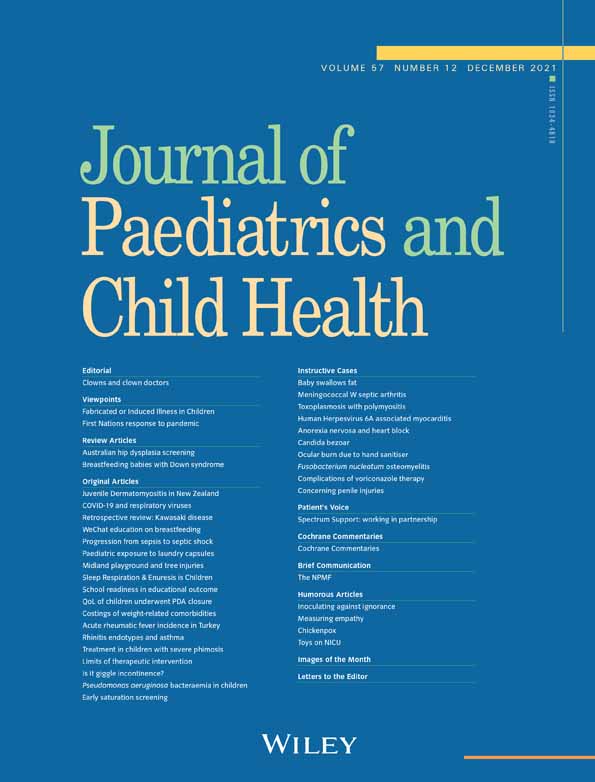Poor Hygiene as a Risk Factor in the Development of Brain Abscess in Adolescents
Conflict of interest: None declared.
POOR HYGIENE AS A RISK FACTOR IN THE DEVELOPMENT OF BRAIN ABSCESS IN ADOLESCENTS
Brain abscess is a rare life-threatening infection in children. Previous studies have determined main risk factors were ear, nose, throat infections and meningitis.1, 2 Here, we present a case series of 21 children admitted to our institution from January 2009 to March 2021, with confirmed brain abscess with microorganisms identified in abscess, blood or cerebrospinal fluid culture by conventional culture methods or 16S RNA sequencing. Risk factors, demographics, treatment and long-term outcomes are described in Table 1. We highlight one adolescent with the unique risk factor of poor general hygiene.
| Characteristics | (n = 21) | |
|---|---|---|
| Risk factors | NIL | 7 (33.3) |
| Cardiac disease | 4 (19.1) | |
| Prematurity | 3 (14.3) | |
| Otorhinological infection | 2 (9.5) | |
| Odontogenic infection and poor hygiene (our case study) | 1 (4.8) | |
| Infected VP shunt | 1 (4.8) | |
| Brain tumour | 1 (4.8) | |
| Immunodeficiency | 1 (4.8) | |
| Cerebral haemorrhage due to AVM | 1 (4.8) | |
| Treatment | ||
| Surgical interventions | External ventricular drain insertion ± VP shunt | 5 (19.1) |
| Stereotactic transtubular drainage | 2 (9.5) | |
| Craniectomy and aspiration | 2 (9.5) | |
| Burrhole evacuation of abscess and grommet insertion | 1 (4.8) | |
| Surgical debridement and washout | 1 (4.8) | |
| Medical therapy only | 10 (47.6) | |
| Microorganisms identified † | ||
| Gram-positive cocci (aerobic) | Streptococcus intermedius | 3 (10.3) |
| Group B streptococcus (S. agalactiae) | 3 (10.3) | |
| Coagulase-negative Staphylococcus sp. (CONS) | 2 (6.9) | |
| Streptococcus constellatus | 1 (3.4) | |
| Streptococcus pneumoniae | 1 (3.4) | |
| Staphylococcus aureus (MRSA) | 1 (3.4) | |
| Enterococcus faecium | 1 (3.4) | |
| Enterococcus faecalis | 1 (3.4) | |
| Gram-positive bacilli (aerobic) | Bacillus sp. | 1 (3.4) |
| Gram-negative (aerobic) | Enterobacter cloacae | 3 (10.3) |
| Pseudomonas aeruginosa | 2 (6.9) | |
| Acinetobacter baumannii | 1 (3.4) | |
| Serratia marcescens | 1 (3.4) | |
| Haemophilus paraphrophilus (HACEK organism) | 1 (3.4) | |
| Escherichia coli | 1 (3.4) | |
| Anaerobic bacteria | Parvimonas micra | 1 (3.4) |
| Anaerobic Streptococcus sp. | 1 (3.4) | |
| Prevotella sp. | 1 (3.4) | |
| Actinomyces sp. | 1 (3.4) | |
| Others | Mycobacterium bovis (BCG) | 1 (3.4) |
| Candida albicans | 1 (3.4) | |
- † Five patients had polymicrobial infections, as follows: Patient 1 had 2 species of coagulase-negative staphylococci and Enterobacter cloacae; patient 2 had Acinetobacter baumannii and Candida albicans; patient 3 had Parvimonas micra and Streptococcus intermedius; patient 4 had Pseudomonas aeruginosa, Actinomyces sp., anaerobic Streptococcus sp. and Prevotella sp.; patient 5 had Enterobacter cloacae and Enterococcus faecalis (at different time courses).
- AVM, arteriovenous malformation; NIL, nothing; VP, ventriculoperitoneal.
A previously well 15-year-old boy presented to the emergency department with headache and vomiting for 4 days, drowsiness for 6 days and change in behaviour for 2 weeks. He was febrile at 40°C and found to have drowsiness, anisocoria, right VII nerve palsy, decorticate posturing of the right upper limb and brisk right knee reflexes. He was immediately intubated for concerns of raised intracranial pressure, and both computed tomography and magnetic resonance imaging of the head revealed a left frontal lobe cerebral abscess. He underwent surgical drainage of the abscess, and both blood and abscess cultures grew Streptococcus intermedius.
There was a significant history of poor personal hygiene. Due to excessive video gaming, bathing occurred fortnightly-monthly. His complicated social history suggested some neglect from his parents. Furthermore, the neurosurgeon found a thick layer of grime on his scalp prior to incision.
Dental examination revealed a singular small right incisor caries and poor dental hygiene. There have been many reports of Streptococcus intermedius odontogenic infection leading to brain and liver abscesses.3, 4 However, because it was small and not associated with odontalgia, the dental surgeon deemed it unlikely to be his only risk factor. There was no evidence of ear, nose, throat infection. Extensive microbiological investigations were negative for other bacteria (including tuberculosis), viruses, fungi and parasites. Echocardiography revealed a structurally normal heart with no right-to-left shunts, and immunodeficiency workup was unremarkable.
We suspect that severe and prolonged neglect of personal hygiene was a significant risk factor for his brain abscess. He is currently undergoing treatment with IV ceftriaxone and metronidazole after second surgical drainage of his reaccumulated abscess, with clinical and radiological improvement. Through this case, we wish to highlight the importance of maintaining good personal hygiene in adolescents to prevent deep-seated life-threatening infections such as brain abscesses.




